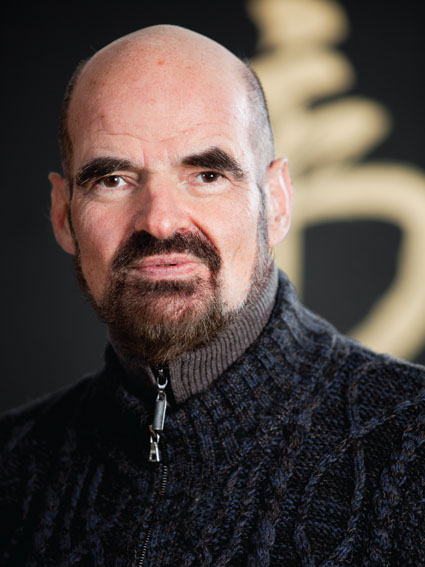What does iWT do differently?
I started practicing the martial arts in the late 1950s.
Suspecting that something decisive was still missing after over 10 years of Judo, JiuJitsu, Karate, Kempo, Taekwondo, Hapkido etc., I found it in 1970, in *ing *un:
In 1970, in the Wing Chun of Joseph Cheng (London),
In 1976 in the WingTsun of Leung Ting and
In 1979 in the Non-Classical Gung Fu of Jesse Glover, the 1st student,1st assistant and best fighter of Bruce Lee.
 |
What I was missing was a logical and clear system rather than a catalogue of hundreds of individual techniques to be learned by heart, and I found this best presented in the WingTsun style of my SiFu Leung Ting.
40 years later – in 2000 when I obtained my 10th master grade in WingTsun and was therefore at a much higher level – I developed a similar suspicion when I examined the functionality of the Grand Principle of all WingTsun, Ving Tsun or Wing Chun styles (“Stick to what comes, accompany home what goes and thrust forward when you lose contact!”) for various universities.
When I was probably the first to take WingTsun to the university in the 1990s, and made it a scientific topic with respect to its combat logic, I recognised this:
One personal style of WingTsun, even the style we deem to be the best as the one taught to us by our own SiFu, can never be a “scientific” WingTsun.
It simply carries with it too many preferences and dislikes, prejudices and “blind spots". And too many almost religious traditions and unexamined habits.
It had meanwhile become clear to me that my research had to start with the principles and basic assumptions that a self-defence method or system claims to be based upon.
It is only the inner styles that are really based on principles, and they often formulate these in poetic form for their students.
After suspending my critical judgement for 40 years, and as a 10th master grade in the Yip Man family with the highest membership, I ventured out to apply my own mind and think about WingTsun as a principle and not as a style, to question everything and to start with the only thing of which we can be absolutely sure, namely the physical point of contact which I call the meeting point with the opponent.
I developed my linkage theory, which my mentor Prof. Tiwald kindly praised as my “golden treasure”. I made fair progress with my own thinking, though this was only based on my own experiences with the external styles. It was Horst Tiwald who sent me to his friends in the internal styles and on my further journey and so saved me from reinventing their wheel.
This time I started to research into the theory and practice of around
nine, partly completely unknown, inner martial arts styles,
and by this time I knew clearly what I was not looking for:
• Not for “dead” movements to be learned by rote
• Not for methods mainly based on having to learn a question & answer game by heart
• Nor for methods whose effectiveness is based on brute physical force, endurance, the ability to take punishment, fitness, reactions, instincts, misunderstood spontaneity & creativity and blind aggression.
This journey was fairly linear, because in Prof. Horst Tiwald, my adviser and guileful Ulysses, I had a travel guide who could show me all the stages along the way. While he sat at his desk and followed our (= mine and Natalie’s) discoveries and experiences by email and video, I was his “Telemachos”, his “fighter in the distance”, and that is how I signed my reports to him.
What aspects of the inner arts have I adopted into my iWT?
Not techniques and movements, as WingTsun already has enough of them.
First of all, my study of the inner styles helped me to replace “dead movements” with “living movement”. This was the first step, and some inner styles do not go beyond it.
Not without help, I later managed to extend my gaze to thinking in terms of points, lines, curves and sheer energy.
To this end I adopted the following:
• Three-dimensionality, the circular, every movement has a forward and back, a left and right, an up and down, an expanding and contracting.
• Balance and therefore relaxation. The separation of Yin & Yang, very simple energy management that acts upon a powerful movement motor and takes its effect with the help of a clear structure.
• Natural opening & closing of the joints, joint & fascia power, use of the horizontal rotation, and also shifting the bodyweight.
• The use of indirect rather than direct forces. Multi-vectored attacks.
• Specific use of convex & concave.
• Sticking to the physical contact point, incl. the use of suction. Compelling the opponent to remain in contact by creating and offering a sphere with corresponding pressure.
• No resistance, but not the opposite either – giving way or running away from the point!
• No automatic, blind reactions, but in the Zen-Buddhist sense of Prof. Tiwald, mindful and fully conscious actions for as long as one's own skill level allows.
I hopefully assume that at the time, the WingTsun of Dr. Leung Jan1 (1816 - 1891) still possessed these inner aspects, which result in superior fighting prowess.
This is suggested by a number of quotations and indications embedded in the forms.
I also believe I recognise indicators in the old WT solo forms that inner aspects at least played a guiding role during the creation of WingTsun (Ving Tsun, Wing Chun).
Unlike his own KungFu grandfather Dr. Leung Jan, the famous YIP MAN unfortunately wanted nothing to do with the inner aspects of WingTsun. The approx. 10 year-old Yip Man learning from his SiFu Chan Wah Shun was not mature enough for these concepts, which even students three times this age could not understand. And later he clearly thought little of them too.
This is nothing against GGM Yip Man, who like Bruce Lee, whom one can certainly mention in the same breath in this case, was responsible for WingTsun – however you spell it – becoming the largest and most famous KungFu style.
Bruce Lee often spoke favourably of inner aspects, but died too young to be able to concern himself with them intensively enough. Kaicho Jon Bluming was probably one of the best fighters of his time, but his skill was not based on inner methods. The boxing genius Muhammad Ali achieved his knockouts without inner forces. No MMA fighter I know of is an inner stylist. GM Gokor does not need any Yin/Yang forces for his famous leg locks!
Inner KungFu is a refinement, an optimisation of all 7 capabilities. It costs time and energy that most would rather invest in acquiring more techniques or improving stamina. Which is perfectly alright too.
For most embarking on the path of Inner KungFu, this consummation aspect is the very highest level of martial arts skill. For them it is no longer a matter of beating an external opponent. Usually a master of an internal art is not in the first flush of youth, has already learned external martial arts for many years and has already fought the fights he needed to.
Fighting with the aim of defeating others becomes less and less important. It is self-examination, self-observation and self-recognition that come to the forefront: Can I unify my body? Can I stay aware – even in the stress of combat? You continue to expose yourself to stressful combat situations, yet fighting is no longer the goal but only the means whereby the level of your personal consummation is tested. How mindful can I be, and how conscious under stress, before I revert to instinctive, blind and animal-like fighting?
Perhaps this is an explanation why masters of inner KungFu show little interest in demonstrating their amazing skills, which can undoubtedly be used profitably in combat, in full-contact competitions.
Did I also look at the southern *ing *un styles that do not belong to the Yip Man lineage? Of course this is the first thought that occurs to one, but that is after all where I started my journey in 1970:
My first tutor, Joseph Cheng, had learned from Lee Sing, who himself learned from numerous other lines in *ing *un, incl. the Dr. Leung Jan variant, before he received instruction from YIP MAN. During a second visit I was able to discover traces of individual aspects I was seeking, but only because I knew what I was looking for.
So if it turns out that in my love of WingTsun, I obtain more from it than was there before, that too will not dismay me as a scientist seeking to create knowledge. Because further development must always take precedence over mere preservation. At least when we are talking about optimum self-defence in a real confrontation.
So let's all continue on our exciting iWT journey together!
Your SiFu/SiGung
Keith R. Kernspecht
_______________________________________
1 Careful: Nowadays a book entitled "Dr. Leung Jan Wing Chun" or schools bearing the name may have someone behind them who has not the slightest connection to Dr. Leung Jan, but instead learned some Yip Man style from Hong Kong.




